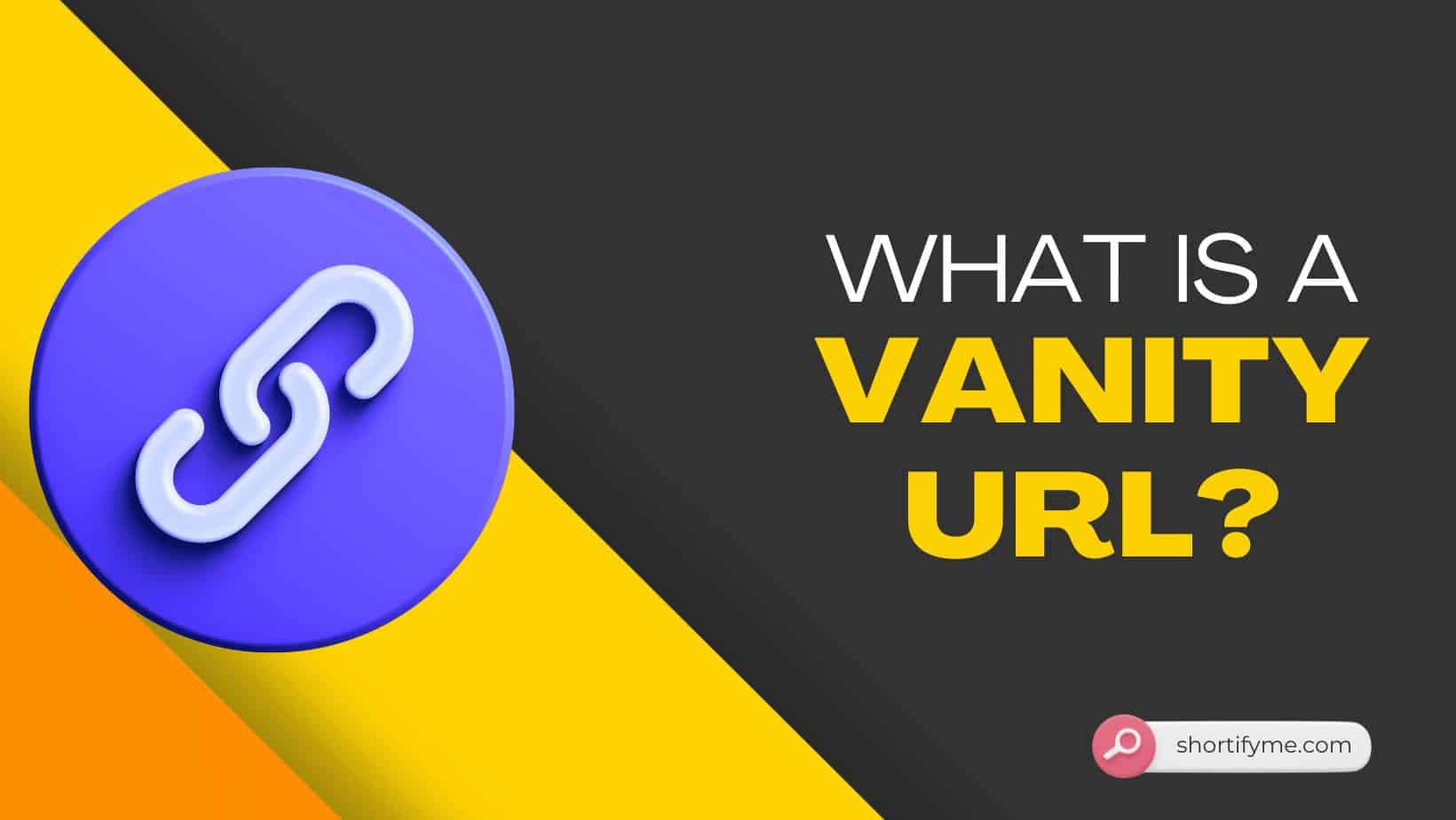Are your URLs as forgettable as yesterday’s news? Tired of sharing long, messy links that no one bothers to click? Enter the world of vanity URLs—a solution to your digital anonymity. Say goodbye to complex strings of characters and hello to personalized, memorable links that make an impact. Discover how vanity URLs can transform your online presence and help you stand out in a sea of generic web addresses.
A. Definition of Vanity URL
It’s a custom-crafted address that reflects your identity, tells your story, and makes you stand out in the digital landscape.
A vanity URL is your digital signature, a customized web address that goes beyond the mundane strings of characters.
It is a carefully crafted link that reflects your brand or identity, creating a memorable and user-friendly experience for your audience.
Unlike traditional URLs, vanity URLs are not just a means to an end; they are an integral part of your digital persona.
B. Importance in the Digital Age
Forget clunky, confusing links – imagine a short, sweet address that instantly tells people what you’re about and where to find your awesome stuff. That’s the magic of vanity URLs, and they’re more important than ever in today’s digital world.
Here’s why:
- Easy to Remember: No more scrambling for random letters and numbers. A good vanity URL sticks in your brain like a catchy song, making it easier for people to share and find you again.
- Brand Booster: Ever heard someone say “Google it”? Vanity URLs become part of your brand name, helping people associate you with a specific web address. This builds recognition and trust, which is gold in the online world.
- Smoother Experience: Forget bouncing between confusing pages. A clear, relevant vanity URL takes users straight to what they’re looking for, keeping them happy and engaged.
So, whether you’re a budding entrepreneur, a creative artist, or just someone who wants to stand out online, a vanity URL is your secret weapon.
It’s like giving your digital footprint a polished look, making it easier for people to connect with you and experience your awesomeness.
Understanding Vanity URLs
A. Structure of Vanity URLs
The structure of a vanity URL typically includes the main domain or website address, followed by a customized and often meaningful keyword or phrase.
For example, a regular URL might look like this: https://www.example.com/products/item123, while a vanity URL for the same page could be something like: https://www.example.com/best-product.
B. Comparison with Regular URLs
1. Memorability:
-
- Vanity URLs: These are intentionally crafted to be memorable and user-friendly. They often contain relevant keywords, brand names, or slogans, making them easier for users to recall.
- Regular URLs: Typically consist of random strings of characters, numbers, and symbols, which may be challenging for users to remember accurately.
2. Brand Identity:
-
- Vanity URLs: Enable organizations to incorporate their brand elements directly into the URL. This helps in reinforcing brand identity and making the link an extension of the brand itself.
- Regular URLs: Lack the customization to reflect a brand’s identity and are often generic and less visually appealing.
3. Marketing and Promotion:
-
- Vanity URLs: Commonly used in marketing campaigns and promotions. They offer a clean and concise way to promote specific products, events, or landing pages.
- Regular URLs: Are less suitable for promotional purposes due to their generic nature and lack of customization.
4. Aesthetics:
-
- Vanity URLs: Tend to be aesthetically pleasing, contributing to a cleaner and more professional appearance on marketing materials, social media, and other platforms.
- Regular URLs: Can appear cluttered and less visually appealing, especially when shared in marketing materials or on social media.
5. Ease of Sharing:
-
- Vanity URLs: Easy to share verbally, in print, or digitally due to their simplicity and memorability. This ease of sharing can contribute to increased click-through rates.
- Regular URLs: May be prone to errors in transcription or memory recall, leading to potential issues when shared.
6. SEO Impact:
-
- Vanity URLs: While they may have a limited impact on SEO, incorporating relevant keywords can contribute to better search engine visibility for specific pages or content.
- Regular URLs: The impact on SEO is primarily determined by the content and structure of the website rather than the URL itself.
7. User Trust:
-
- Vanity URLs: Customized links that include brand elements can instill a sense of trust and legitimacy, as users may associate them with official and credible sources.
- Regular URLs: May appear less trustworthy, especially when used in contexts where users are cautious about clicking on unfamiliar links.
C. Examples of Vanity URLs in Action
Let’s explore some real-world examples to understand how vanity URLs are effectively utilized:
- Nike: Instead of a generic product page URL, Nike might use a vanity URL like https://www.nike.com/airmax to promote their Air Max line of sneakers.
- Google: Google often uses vanity URLs for specific marketing campaigns or events, such as https://events.google.com/io for their annual Google I/O developer conference.
- Bitly: A URL shortening service like Bitly allows users to create custom short links, turning lengthy URLs into more manageable and branded versions, like https://bit.ly/yourbrand
- Coca-Cola: In a marketing campaign, Coca-Cola might use a vanity URL like https://us.coca-cola.com/holidays to promote their holiday-themed products.
These examples illustrate how vanity URLs can be tailored to convey specific messages, enhance brand presence, and simplify the user experience in various industries and contexts.
Benefits of Vanity URLs
Vanity URLs offer several benefits, primarily focused on enhancing user experience, brand visibility, and the effectiveness of marketing efforts. Here are some key advantages:
1. Memorability:
Vanity URLs are designed to be easy to remember, often incorporating brand names, slogans, or relevant keywords. This increases the likelihood that users will recall and accurately type the URL.
2. Brand Identity:
Custom URLs allow organizations to integrate their brand elements directly into the web address. This reinforces brand identity and helps establish a consistent and recognizable online presence.
3. Marketing and Promotions:
Vanity URLs are commonly used in marketing campaigns and promotions. They provide a concise and visually appealing way to promote specific products, events, or campaigns, making it easier for users to engage.
4. Aesthetics and Professionalism:
Vanity URLs contribute to a cleaner and more professional appearance, both online and offline. Their customized nature enhances the overall aesthetic of marketing materials, social media posts, and other communication channels.
5. Easy Sharing:
Due to their simplicity and memorability, vanity URLs are easy to share verbally, in print, and across digital platforms. This ease of sharing can lead to increased click-through rates and better engagement.
6. Tracking and Analytics:
Many vanity URL services and custom domain providers offer analytics tools. Users can track the performance of their links, monitor click-through rates, and gather insights into user behavior, contributing to data-driven decision-making.
7. Search Engine Optimization (SEO):
While the impact on SEO may be limited, incorporating relevant keywords into vanity URLs can still contribute to better search engine visibility for specific pages or content.
8. User Trust and Credibility:
Custom URLs that include brand elements can instill a sense of trust and credibility in users. They may be more likely to click on a link that appears to be associated with an official and recognizable source.
9. Enhanced User Experience:
Vanity URLs contribute to an enhanced user experience by making web addresses more user-friendly. Users are more likely to engage with links that are clear, concise, and aligned with their expectations.
10. Offline Promotion:
In offline marketing materials such as brochures, business cards, or advertisements, vanity URLs provide a neat and memorable way to direct individuals to specific online content.
11. Flexibility and Adaptability:
Vanity URLs can be easily adjusted or updated to align with changing marketing strategies, promotions, or branding initiatives. This flexibility allows organizations to stay agile in their online presence.
How to Create a Vanity URL
Creating a vanity URL typically involves a few steps, and the specific process may vary depending on the platform or service you are using. Here’s a general guide on how you can create a vanity URL:
1. Select a Platform or Service:
Choose a platform or service that allows you to create custom or vanity URLs. Popular choices include URL shortening services, custom domain providers, or content management systems (CMS) that support custom URLs.
2. Choose a Domain:
If you’re creating a custom URL for a specific page or content, decide if you want to use an existing domain or set up a new one. Some platforms allow you to use subdomains (e.g., custom.yourdomain.com).
3. Shorten or Customize the URL:
If you’re using a URL shortening service like ShortifyMe, you can paste your original URL and customize the short link. Some services may also allow you to choose a specific keyword or phrase to include in the URL.
4. Utilize Customization Features:
Depending on the platform, you might have options to customize other aspects of the URL, such as adding relevant keywords, branding elements, or specifying a path that aligns with the content you’re linking to.
5. Verify Availability:
Ensure that the custom URL you want is available and not already in use. Some platforms may provide suggestions if your desired URL is already taken.
6. Configure Redirects (If Necessary):
If you’re setting up a custom URL for a specific page or content on your website, configure any necessary redirects. This ensures that users are directed to the correct destination when they access the custom URL.
7. Promote Your Vanity URL:
Once created, start using and promoting your vanity URL in your marketing materials, social media, or any other channels where you want to increase visibility.
8. Monitor Performance:
Many URL shortening services and custom domain providers offer link analytics tools. Monitor the performance of your vanity URL to understand how many clicks it receives and gather insights into user engagement.
Use Cases and Examples
Here are specific use cases and examples of vanity URLs in various contexts:
A. Business and Corporate Applications
1. Branding Strategies:
Example: Coca-Cola utilizes vanity URLs like https://us.coca-cola.com/shareacoke for their “Share a Coke” campaign, enhancing brand visibility and providing an easy-to-remember link for consumers.
2. Product Launches:
Example: Apple often uses custom URLs, like https://www.apple.com/iphone, for the launch of new products. This not only simplifies the link but also reinforces the brand identity with the product name in the URL.
3. Event Promotion:
Example: IBM may create vanity URLs such as https://ibm.com/cloudsummit for promoting cloud-related events, making it easy for attendees to access event details and resources.
4. Internal Communications:
Example: Large corporations might use vanity URLs for internal communications, such as https://companyintranet/employeehandbook simplifying access to important resources for employees.
B. Social Media and Personal Branding
1. Influencer Profiles:
Example: Social media influencers often use custom short links on platforms like Instagram, directing followers to their latest blog posts, YouTube videos, or affiliate products. For instance, https://influencername.com/latestvideo
2. Resume and Portfolio:
Example: Professionals may use vanity URLs on their resumes or business cards, like https://yourname.com/resume to provide a direct link to their online portfolio or LinkedIn profile.
3. Online Courses or Consulting:
Example: A consultant might use a vanity URL such as https://consultantname.com/training to promote online courses, making it easy for clients to access educational resources.
C. Campaigns and Promotions
1. Limited-Time Offers:
Example: Amazon might use a vanity URL like https://amazon.com/primeday during their Prime Day sale, creating a memorable link for users interested in exploring exclusive deals.
2. Social Media Campaigns:
Example: Starbucks could employ a vanity URL such as https://starbucks.com/summer for a summer-themed social media campaign, driving traffic to a dedicated page with seasonal promotions.
3. Non-Profit Fundraising:
Example: A charitable organization might utilize a vanity URL like https://givehope.org/donatenow for a specific fundraising campaign, making it easy for supporters to contribute.
D. Shortened URLs vs. Vanity URLs
1. Shortened URLs:
Example: ShortifyMe’s shortened URL like “https://shortifyme.co/yourshortlink” is effective for concise sharing on social media or when character count is crucial, but it lacks the customized and branded elements of a vanity URL.
2. Vanity URLs:
Example: Nike’s vanity URL “https://nike.com/justdoit” not only shortens the link but also incorporates the iconic slogan, enhancing brand recognition and providing a memorable link for marketing purposes.
3. When to Use:
- Shortened URLs: Ideal for character-limited platforms, quick sharing, or when the focus is purely on link length.
- Vanity URLs: Best suited for branding, marketing campaigns, and situations where brand identity and memorability are crucial.
Understanding the use cases and examples across different domains illustrates the versatility and impact of vanity URLs in shaping online presence, marketing strategies, and personal branding.
Common Misconceptions
The concept of Vanity URLs often intersects with various misconceptions, leading to confusion and misinformation. In this part of the blog, we aim to untangle some prevalent misunderstandings surrounding Vanity URLs.
A. Vanity URLs vs. Redirects
Misconception: Vanity URLs and redirects are the same things.
Truth:
- Vanity URLs: These are customized, user-friendly web addresses designed for easy recall and brand reinforcement. Vanity URLs can lead to specific pages on a website but are not inherently synonymous with redirects.
- Redirects: Redirects are instructions that automatically take a user from one URL to another. While a vanity URL can involve a redirect, not all redirects are vanity URLs. A redirect can be set up for various reasons, including URL shortening or restructuring.
Clarification:
- Vanity URLs are about branding and user experience.
- Redirects are about routing traffic from one URL to another.
B. SEO Implications
Misconception: Vanity URLs significantly impact SEO rankings.
Truth:
- Vanity URLs: While they can include relevant keywords, the impact on SEO is generally limited. Search engines primarily focus on the content and structure of the webpage rather than the URL.
- SEO Impact: Vanity URLs with strategic keywords can contribute to better search engine visibility for specific content, but other on-page SEO factors are more crucial.
Clarification:
- Vanity URLs may have a subtle influence, but comprehensive SEO strategies should address various aspects of webpage optimization.
C. Security Concerns
Misconception: Vanity URLs are inherently less secure than regular URLs.
Truth:
- Vanity URLs: The security of a vanity URL depends on the underlying infrastructure and the website it leads to. Vanity URLs themselves do not inherently compromise security.
- Security Measures: Implementing HTTPS, using secure servers, and adhering to best security practices ensure the safety of both regular and vanity URLs.
Clarification:
- Vanity URLs are as secure as the websites they point to; best security practices must be applied universally.
D. Case Sensitivity
Misconception: Vanity URLs are case-sensitive, and capitalization affects functionality.
Truth:
- Vanity URLs: In most cases, vanity URLs are not case-sensitive. Modern web servers and browsers treat URLs as case-insensitive, providing a consistent user experience.
- Uniformity: While capitalization doesn’t typically affect functionality, it’s advisable to maintain consistency for branding and user expectations.
Clarification:
- Users can generally type vanity URLs with any combination of uppercase and lowercase letters without impacting the link’s functionality.
Future Trends in Vanity URLs
As digital landscapes continue to evolve, several trends are anticipated to shape the future of Vanity URLs. These trends reflect the dynamic nature of online communication, branding strategies, and user experience. Here are some potential future trends in Vanity URLs:
1. Integration with Augmented Reality (AR) and QR Codes:
- Vanity URLs may become seamlessly integrated with AR experiences and QR codes, providing users with an interactive and engaging way to access customized content.
2. Dynamic Personalization:
- The future might see the rise of dynamically personalized Vanity URLs that adapt based on user behavior, preferences, or demographic information, providing a more tailored user experience.
3. Voice Search Optimization:
- With the increasing prevalence of voice-activated devices and search, Vanity URLs could be optimized for voice search, ensuring that they are easily pronounceable and recognizable when spoken.
4. Blockchain-based Vanity URLs:
- Blockchain technology could be leveraged to enhance the security and authenticity of Vanity URLs, providing users with increased trust and transparency in the digital space.
5. AI-driven Customization:
- Artificial Intelligence (AI) could play a role in dynamically generating or suggesting Vanity URLs based on brand messaging, current trends, and user preferences, optimizing the link creation process.
6. Incorporation into Virtual Spaces:
- As virtual reality (VR) and virtual spaces become more prevalent, Vanity URLs might find their way into these environments, serving as a bridge between the physical and virtual realms.
Final Words
This concludes our journey into the captivating world of vanity URLs. Remember, it’s not just about looking good, it’s about unleashing their strategic potential to achieve your online goals.
Embrace the power of vanity URLs! Craft your digital destiny with elegance and purpose.
They’re not just pretty faces; they’re powerful tools that can elevate your online presence, enhance user experience, and ultimately, lead you to success in the ever-evolving digital landscape.
I hope this comprehensive guide has equipped you with the knowledge and inspiration to create your own vanity URL masterpiece!


